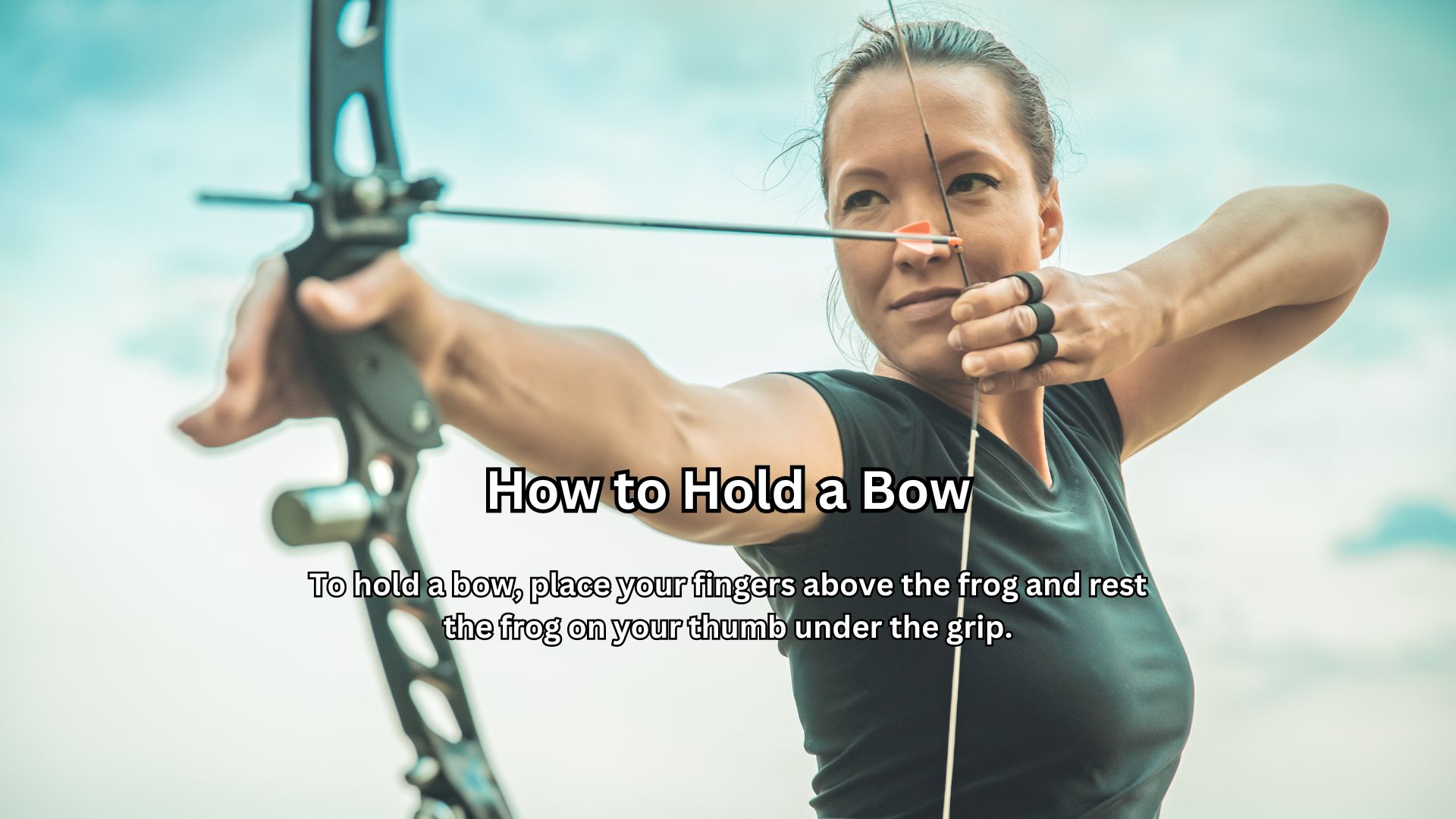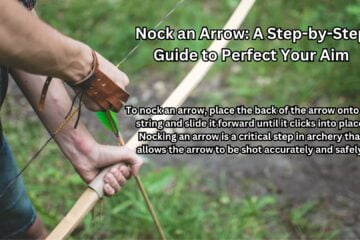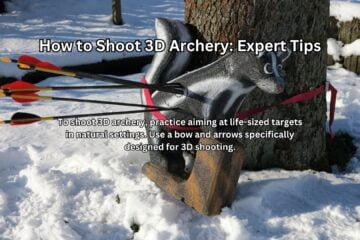To hold a bow, place your fingers above the frog and rest the frog on your thumb under the grip.
Although this may sound simple, holding a bow can be challenging for beginners. The hold must be firm but not too tight, and the fingers must be positioned correctly. Proper holding of the bow ensures that the instrument can produce the best sound quality without causing any discomfort to the player’s hands.
Ultimately, holding a bow requires patience, practice, and good technique. With proper guidance and practice, you can master the art of holding a bow, which would enhance your performance on any stringed instrument.
Key Benefits Of Mastering The Art Of Holding A Bow
Benefits Of Mastering How To Hold A Bow Properly
For anyone embarking on their archery journey, learning how to hold a bow properly is essential. It is the foundation upon which all future skills will be built. In addition to laying a foundation for archery skills, mastering the art of holding a bow can have several other benefits:
Improved Accuracy
By holding the bow correctly, you can greatly increase your accuracy. When you hold the bow consistently, the natural fluctuations that may occur when holding the bow improperly are eliminated. As a result, consistently holding the bow properly can lead to improved accuracy with each shot.
- A consistent grip on the bow can lead to a consistent draw length, which can improve overall accuracy.
- Proper handling of the bowstring can make sure the arrow is placed in the same position every time, leading to improved targeting.
Muscle Memory
Another benefit of mastering how to hold a bow properly is developing muscle memory. Archery is a highly technical sport that requires fine motor skills and repetition. By holding the bow properly, you can create muscle memory, reducing the number of variables that need to be considered when taking a shot.
- Muscle memory reduces the need to concentrate on achieving proper holding and can lead to more focus on the actual shot and form.
- Consistently holding a bow properly can help establish proper form and technique.
Building Confidence
Building confidence is another benefit of mastering how to hold a bow properly. Having a consistent grip on the bow can create a foundation for success, by allowing the archer to reproduce successful shots and engage in positive feedback.
- Consistent success can create a sense of accomplishment and lead to greater overall confidence in archery and life.
- The more confident you are, the more relaxed and focused you can be, which can ultimately lead to better shooting.
So there you have it, mastering the art of holding a bow properly is essential for success in archery. By improving accuracy, developing muscle memory and building confidence, proper grip can lay a solid foundation for all of your archery skills.
Foundation Of Holding A Bow
As a beginner, one of the most important things you should learn when shooting a bow is how to hold it properly. The foundation of holding a bow is crucial because it sets the tone for good form and accuracy.
To achieve this, there are some fundamental principles you need to follow, which we will discuss in detail below:
Keeping Your Grip Relaxed
One common mistake many beginners make is gripping the bow tightly. This can cause your shots to be inaccurate and tense up your forearm muscles. To avoid this, here are some tips to keep your grip relaxed:
- Hold the bow in your non-dominant hand with the arm extended fully
- Avoid gripping the bow handle and focus on placing your thumb over the top of the grip and your other four fingers securely around the back of the bow
- Ensure that you’re not squeezing the bow too hard and that your grip is comfortable but firm
Proper Finger Placement On The String
Another key principle in holding a bow is proper finger placement on the string. Without this, you won’t be able to draw the bowstring correctly, resulting in poor form and accuracy.
- Use three fingers to place on the string (index, middle, and ring fingers).
- Place your fingers below the nocking point on the string
- Keep your fingers together as if holding a pen
- Ensure that your fingers are curved slightly over the string
Finding The Balance Point Of Your Bow
Finding the balance point of your bow is critical as it will provide better control and stability when shooting. This principle will vary based on the type of bow you use, but here are some tips to help you find it:
- Hold the bow grip with your non-dominant hand and place your index finger under the upper limb and your thumb under the lower limb.
- Shift your index finger up or down the upper limb and find the point where the bow is balanced.
- Use a bow square to identify the position of the bowstring on the bow.
- Move the stabilizer to adjust for balance.
As you work on improving your archery skills, mastering the principles of holding a bow is essential. With these tips, you’re on your way to developing a good foundation in archery, helping you achieve better accuracy and form. Remember, practice makes perfect, so keep learning, refining, and perfecting your holding technique.
Types Of Bow Grip
Bow hunting is a fascinating sport that requires patience, strategy, and precision. It requires mastering various techniques, such as holding the bow correctly, aiming, and releasing the arrow. In this blog post, we will discuss one of the most fundamental aspects of archery- how to hold a bow.
Specifically, we will focus on three types of bow grip: the three-finger-under grip, the split-finger grip, and the Mediterranean draw. We will explore the advantages and drawbacks of each grip style and help you identify which one would best suit your needs and preferences.
Three-Finger-Under Grip
One of the most popular and beginner-friendly bow grips is the three-finger-under grip. It involves placing the index, middle, and ring fingers below the arrow, while the thumb and little finger rest above the arrow. Here are the key points to note about the three-finger-under grip:
- Advantages:
- It provides a stable and comfortable grip on the bow.
- It helps maintain consistency and accuracy in shots.
- It is easy to learn and perfect for beginners.
- Drawbacks:
- It may not be ideal for individuals with long fingers or thick hands.
- There is a risk of pinching the arrows while shooting.
- It may not generate as much power as other grip styles.
Split-Finger Grip
Another popular bow grip technique is the split-finger grip. This technique involves placing the index finger above the arrow, and the middle and ring fingers below the arrow. Here are some of the advantages and disadvantages of this grip style:
- Advantages:
- It generates more power and speed, making it ideal for shooting longer distances.
- It offers better control over the bow, especially in windy conditions.
- It reduces the chances of pinching the arrow while releasing the shot.
- Drawbacks:
- It requires more practice and patience to master the technique.
- It may cause blisters and calluses on the fingers.
- It may not be as comfortable as the three-finger-under grip for beginners.
Mediterranean Draw
The Mediterranean draw, also known as the ‘three-under’ technique, is a popular grip style among target shooters, especially in Mediterranean regions. Unlike the previous two techniques, this technique involves placing three fingers below the arrow. Here are the advantages and drawbacks of this grip style:
- Advantages:
- It provides a solid and strong grip on the bow.
- It generates high power, especially when shooting heavy bows.
- It helps maintain good form and posture in shots.
- Drawbacks:
- It requires significant practice and patience to master the technique.
- It may cause finger numbness and pain in some cases.
- It may not be suitable for beginners or individuals with weak hand muscles.
Mastering the art of bow grip is crucial for any archer- be it a beginner or a pro. The type of grip style you choose depends on your individual needs, preferences, and skill level. We hope that this guide has provided you with useful information on the three most popular bow grip styles and their advantages and drawbacks.
Try out each technique and identify which one works best for you, and don’t forget to practice, practice, practice!
Common Mistakes To Avoid
Common Mistakes To Avoid When Holding A Bow
Holding a bow might seem like one of the easiest things to do, but it’s also one of the most overlooked components of archery. Beginners may unknowingly make mistakes when holding a bow, which can negatively impact their performance and accuracy.
Here are the most common mistakes beginners make when holding a bow and how to identify and correct them:
- Gripping the bow too tightly: Holding the bow too tightly can cause unnecessary tension in your arms and shoulders, resulting in poor shot execution and accuracy. To rectify this, try relaxing your grip, holding the bow loosely in your hand, and using your bow hand’s heel as a connection point.
- Improper hand placement: Placing your bow hand too high or too low on the grip can cause your shots to veer off to one side. The correct position is to place your bow hand directly in the middle of the grip, maintaining a consistent grip position for every shot.
- Incorrect finger placement on the bowstring: Incorrect finger placement on the bowstring can affect the way your arrow flies. Beginners who place their fingers too high above the arrow nock or too low below it may hinder the arrow’s flight. To fix this, position your fingers correctly on the bowstring, ensuring that they are consistent with each shot.
- Slouching posture: Hunching over or poor posture can cause tension in your upper body, resulting in inaccuracies. To rectify this, stand up straight, maintain good posture, and relax your shoulders before releasing the shot.
Correcting the above mistakes can significantly improve your accuracy and overall performance in archery. As a beginner, focusing on the correct bow-holding technique from the start can prevent developing bad habits and lead to a more productive practice session.
Exercises And Drills To Improve Bow Grip
Bow grip is a fundamental element of archery, and without proper control over it, an archer cannot shoot straight or achieve desirable precision. After learning about the essential aspects of bow grip, including hand placement and pressure points, archery enthusiasts can enhance their accuracy and consistency by following specific exercises and drills.
In this blog post, we will cover some beginner-friendly and advanced drills to improve your bow grip.
Beginner-Friendly Drills:
The following exercises are suitable for the beginners who want to strengthen their bow grip:
- Finger placement drill: Hold the bow with your relaxed fingers and thumb. Place your first finger around the bow grip, then your second finger around the grip, and so on. Repeat this exercise until you’ve gone through your entire hand.
- Pencil pushup drill: Hold a pencil with your bow hand and act as if you’re about to shoot an arrow. Slowly squeeze and release the pencil with your fingers while maintaining the same hand placement. This exercise can improve your hand’s strength and endurance.
- Towel squeeze drill: Fold a towel around the bow grip. Squeeze and release the towel with your hand, keeping it in place around the grip. Repeat this exercise until your hand gets tired. This drill helps build finger and forearm muscles, which are necessary for gripping the bow.
Advanced Drills:
The following exercises are more challenging and suitable for advanced archers:
- Balloon squeeze drill: Inflate a balloon and hold it with your bow hand. Squeeze it slowly, imagining that the balloon is your bow grip. Increase the pressure until the balloon bursts. This drill strengthens the muscles needed for a proper bow grip.
- Weighted bow drill: Attach some weights to your bow and hold it with your bow hand. Perform 10 to 15 repetitions of the standard archery form, keeping the bow steady with your hand. This drill trains your hand’s endurance and muscle memory.
- Blindfolded shooting drill: Blindfold yourself and attempt to shoot an arrow. This drill emphasizes the importance of muscle memory and allows the archer to feel the grip’s natural alignment without relying on sight.
Drills and exercises are necessary techniques to improve your bow grip and enhance your archery technique. If you’re a beginner, start with the fundamental drills and gradually transition into more challenging ones. And if you’re an advanced archer, make sure to practice these advanced drills to maintain your grip’s strength and enhance your accuracy.
Frequently Asked Questions For How To Hold A Bow
How Do I Properly Grip A Bow?
To grip a bow, start with the hand you use to write and place your knuckles on top of the bow grip. Keep your wrist straight and your fingers wrapped around the bow, resting lightly against the thumb. With a proper grip, you can control the bowstring and shoot accurately.
How Do I Position My Fingers On The Bowstring?
To place your fingers on the bowstring, use your dominant hand to grip the bowstring between your index and middle fingers, with the arrow resting on the rest. Keep your fingers relaxed and not too tight. This will allow you to release the string smoothly and accurately.
How Do I Aim The Bow?
To aim the bow, align your eye with the center of the bowstring and focus on the target. Keep your arms straight and your body still, and use your dominant eye to aim. Adjust your aim based on the distance and wind conditions.
How Do I Maintain My Bow?
To maintain your bow, regularly inspect the strings for wear and tear, and replace them as necessary. Keep the bow limbs clean and dry, and store the bow in a dry, cool place. Avoid exposing the bow to extreme temperatures or humidity.
What Should I Wear When Holding A Bow?
When holding a bow, wear comfortable and flexible clothing that allows for a full range of motion. Avoid loose clothing that can get caught on the bow. Wear comfortable shoes with good traction to maintain balance and stability.
Conclusion
Properly holding a bow is a crucial aspect of archery. It not only affects the accuracy of your shots but also helps you avoid injury. By following the above guidelines, you can achieve a stable and comfortable grip that enhances your performance.
It’s important to always remember to find the right bow size and weight that suits your body composition to avoid physical discomfort or limitations on your technique. By practicing correct form, you’ll produce consistent and precise shots every time. With the guidelines mentioned above, you can master the art of holding a bow, eliminating any unnecessary movements that may hinder your accuracy.
Regular practice and dedication are essential to developing your skills as an archer. The more you practice, the more natural these guidelines will become, allowing you to focus solely on your aim and enjoy the sport of archery to its fullest potential.







